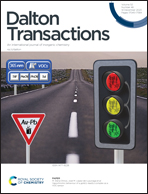Interlayer interaction-force-tuned magnetic responses in CoII-tetrazolate–carboxylate system from canted antiferromagnet to field-induced metamagnet†
Abstract
Interlayer magnetic couplings of low-dimensional magnets have significantly dominated magnetic behavior through skillful regulation of interlayer interacting forces. To identify interaction-force-regulated interlayer magnetic communications, two air-stable Co(II)-based coordination polymers (CPs), a well-isolated layered structure with approximately 12.6 Å interlayer separation and a carboxylate-extended three-dimensional framework with an inter-ribbon distance of 5.8 Å, have been solvothermally fabricated by varying polycarboxylate mediators in a ternary CoII-tetrazolate–carboxylate system. The layered CP with antiparallel-arranged {Co2(COO)2}n chains interconnected only via cyclic tetrazolyl linkages behaves as a spin-canted antiferromagnet with a Néel temperature of 2.6 K, due to strong intralayer antiferromagnetic couplings and negligible interlayer magnetic interactions. In contrast, the compact three-dimensional framework with corner-sharing Δ-ribbons tightly aggregated through μ2–η1:η1-COO− is a field-induced metamagnet from a canted antiferromagnet to a weak ferromagnet with a small critical field of Hc = 90 Oe. Apparently, these interesting magnetic responses reveal the importance of an interacting force from the magnetic subunits for the magnetic behavior of the molecular magnet, greatly enriching the magnetostructural correlations of transition-metal-based molecular magnets.



 Please wait while we load your content...
Please wait while we load your content...